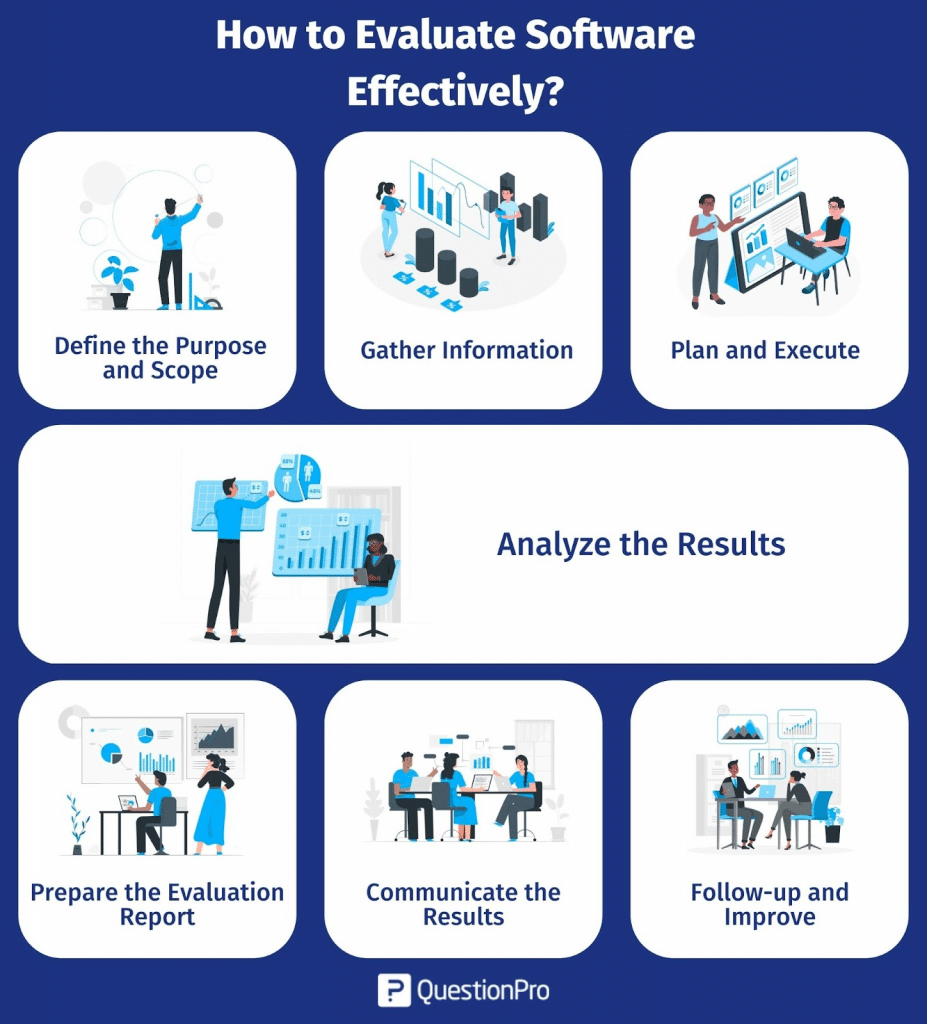
Software evaluation is important for businesses and organizations that want to buy software that meets their needs and gives them a good return on their investment.
It entails evaluating and measuring the quality and effectiveness of software applications in order to determine whether they meet the requirements and specifications, perform the intended functions, and meet the needs of end users.
In this blog, we will look at what software evaluation is and how to do it properly.
What is software evaluation?
Software evaluation determines a software application or system’s quality, usability, and effectiveness.
It is an important step in the software development process because it determines whether the software meets the required standards and specifications and is fit for its intended purpose.
Reviewing the software design, testing the software for functionality and performance, and evaluating the software documentation are all part of the software evaluation process. Software developers, testers, or external evaluators can carry out the evaluation.
Software evaluation is a time-consuming process. In many cases, speaking with vendors and weighing each option takes significant time.
Why is software evaluation important?
Software evaluation is an important step in the software development process because it determines whether the software meets the required standards and specifications and whether it is suitable for its intended purpose. Let’s find out some key importance of it:
- Quality assurance
It is important for quality assurance. By evaluating software, potential problems can be found and fixed early on in the development process. This can help to reduce the number of defects, bugs, and errors in the software. This can save time and money in the long run and improve the software’s overall quality.
- User satisfaction
Software evaluation is critical for user satisfaction. It is possible to determine whether the software meets the needs of its intended users by evaluating it from the user’s perspective. This can help to increase user satisfaction and decrease user frustration with the software.
- Cost-effectiveness
It is essential for determining cost-effectiveness. Software evaluation allows for identifying and resolving potential problems before they arise. This can save time and money by reducing the need for costly rework or redesign in the future.
- Continuous improvement
Evaluating software can provide useful feedback for future software releases. This can help ensure that the software remains up-to-date, meets the changing needs of users, and remains competitive in the market.
LEARN ABOUT: Market Evaluation
Who Should Be Involved in A Software Evaluation?
The process of evaluating software is complicated and will involve a lot of people, such as:
- Stakeholders, including the decision-maker:
These individuals will be crucial in keeping the evaluation on track.
- The people who will use the product
These individuals can provide feedback on whether the software is practical for daily use. Adoption will be more difficult if the software is complex or difficult to use.
- IT and security team
These people can figure out how the software will work technically.
Those who are part of the evaluation process will need to work together to determine if the software is feasible or useful. How big the evaluation team is will depend a lot on the organization’s size and what kind of software is being evaluated.
The evaluation process should be the team’s main focus. The evaluation can start once a team is established.
Criteria of software evaluation
Having a list of criteria to employ during the review process is critical. There are a few things to think about when deciding if the software or software programs will work well for the company:
- Functionality
The software’s functionality is one of the first and most crucial things to consider. The goal is to determine whether the software’s features and functions can solve a major issue, such as making things easier or eliminating errors.
Determining how the software works will probably take a long time, but it is one of the most important steps.
- UI and UX
The software’s user interface (UI) and user experience (UX) must be evaluated. Think about how tech-savvy the users are and whether they will easily adopt the software.
Getting users to accept and use complex and challenging software will be challenging. End-user feedback will be invaluable during this stage of the evaluation process.
- Business case
The new software should only be purchased if it helps to solve a real problem. As a result, your evaluation process should include a business case.
- Pricing
While price should not be the deciding factor, it plays a significant role in determining whether the software will be viable.
How to evaluate software effectively?
A software evaluation is a systematic approach to determining the quality and suitability of the software for a specific purpose. Here are the steps involved in conducting a software evaluation:

- Define the purpose and scope of the evaluation
Before beginning the evaluation, it is critical to define the evaluation’s purpose and scope. This could include defining the evaluation criteria, the software’s intended users, and the expected outcomes of the evaluation.
- Gather information about the software
Gather key facts about the software under evaluation, such as its design, user guides, system requirements, and any known bugs or problems.
- Plan and execute the evaluation
The evaluation team should plan and carry out the evaluation based on the defined purpose and scope. Testing the software for functionality, performance, and usability and reviewing the software documentation may be required.
- Analyze the results
After completing the evaluation, the results should be analyzed to identify strengths, weaknesses, and improvement opportunities. The analysis should be as impartial as possible based on the established criteria.
- Prepare the evaluation report
Make a report that sums up what you learned from the evaluation. The evaluation criteria, a summary of the evaluation process, the results of the evaluation, and suggestions for how to make things better should all be in the report.
- Communicate the results
The evaluation results should be shared with the right people, like the software developers, testers, management, and end users. The result should include the following:
- A summary of what was found.
- Suggestions for how to make things better.
- Any actions that need to be taken.
- Follow-up and continuous improvement
After the evaluation, there should be follow-up activities to make sure that the suggested changes are made and to check on how well the software is working. Activities for continuous improvement should also be done to ensure that the software stays up-to-date and meets users’ changing needs and expectations.
Conclusion
Software evaluation is a critical process for businesses looking to invest in dependable, secure, and efficient software. Evaluating software entails assessing various aspects of the software, such as its features, functionality, usability, reliability, security, performance, scalability, maintainability, and cost-effectiveness.
Businesses can effectively evaluate the software by following the tips outlined in this blog, ensuring that they invest in software that meets their needs and provides value for money.
You can easily and efficiently conduct software evaluations with QuestionPro. Our software evaluation tools allow you to evaluate software features, functionality, usability, reliability, security, performance, scalability, maintainability, and cost-effectiveness.
Whether you want to evaluate your own software or that of a third-party vendor, QuestionPro’s software evaluation tools give you the information you need to make an informed decision.
Try QuestionPro’s software evaluation tools today and take the first step toward investing in software that meets your company’s requirements.
BOOK A DEMO LEARN MORE







